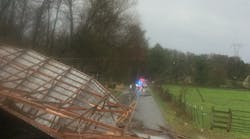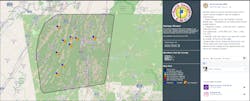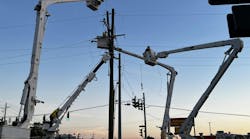In 2010, when North Georgia Electric Membership Corporation first began to explore the concept of automated mobile workforce management, it was hard to imagine gaining acceptance of the high-tech approach for use by the utility’s veteran team of workers. Serving more than 98,000 customers across seven counties in the mountainous northwest corner of Georgia, the co-op’s field crews were used to working independently and solving problems resourcefully, but many lacked basic computer skills, and the co-op was uncertain of their interest to learn those computer skills.
Despite the obstacles, the potential benefits were clear: reduce truck rolls, paper costs, and restoration times; eliminate redundancy and paperwork; link four offices and their field teams to accelerate problem solving; efficient routing of service orders; real-time communication; a “visual” of the location of crews; and most importantly increase the safety of the crews.
“We knew we needed to find a different method,” said VP Member Services Stephanie Holder. “We would sometimes lose paper orders. Sometimes notes would get scribbled on the bottom of orders and we would overlook it. And it wasn’t very environmentally friendly using all that paper.” CEO Kathryn West and her team were determined to take the utility paperless — and to tackle less efficient methods for a stronger corporate culture.
North Georgia EMC was not a complete stranger to the benefits of digitalization. They had put their entire customer information systems (CIS) and business systems (BIS) on a unified platform used daily by the back office. To simplify their approach to bringing field crews more fully into the digital world, North Georgia selected the new software for mobile workforce management and geospatial information systems (GIS) software from Futura Systems, a subsidiary of their CIS/BIS provider SEDC.
To help overcome any uncertainty or unfamiliarity with computer-based systems, North Georgia EMC first offered associates some basic computer training. The software’s trainers came on site first working with the “inside staff” of business and operations team members, showing them how to access integrated data on the new map formats. North Georgia’s dispatchers could use one map to see data -- that had previously only been available on separate, tabular displays – in geographic overlays. For example, a customer’s meter location and account status or service request could be shown along with the location of the closest truck available to fix it. Soon, everyone in the office took to the intuitive interface and felt comfortable using it.
“Next, we started introducing it to our installer collectors and the service crews in the field,” Holder recalled. Field crew paperwork was replaced by mobile devices, either hard books or small, ruggedized laptops (the co-op has since implemented iPads). North Georgia EMC first thoroughly trained office staff that would be using the system internally in all aspects of using the software and the different mobile devices. These reps then took it to the field, riding along in the vehicle with each worker for their first two days using the tools.
The mobile workforce trainers stayed on site at North Georgia EMC over the first few days, showing crews how paperless processes could work in the field, making sure workers knew how to use all of the equipment, and that everything went smoothly.
Gradually, as the new technology began to feel natural to the whole work force, they began to appreciate ways it helped them do their jobs better.
“Field crews realized they didn’t have to worry about anything getting lost,” Holder said. “They can write a note on the device and see it immediately. They can get meter readings without calling in. You just type it in and it’s there.”
In the office, they appreciated the efficiency, too, said Holder. “Not having to print it out, not having to spend time sorting it, not having to spend time scanning it, or adding notes off of paper copies. The software automatically scans everything into the system, reducing the chance of errors. You don’t have to read anyone’s writing. It’s typed in there; it’s very legible.”
Today, North Georgia EMC’s workforce management is completely paperless. “It’s become a communicator, a time saver and a tree saver,” Holder said. “Our member service reps can access mobile orders and respond to member’s questions quickly. They can see if the order is dispatched, en route, on-site, or complete. They can see the field crew’s notes and share the information with the member.”
When an order is ready to be assigned, the dispatcher doesn’t have to make phone calls or check around to know who is in the area. Holder explained, “You just bring up the map and tell the system to assign it to the nearest truck. You don’t have to even think about it, just click the button and tell it what to do. Of course you can pick whichever you want, but it’s nice to know which is the nearest truck for that order. It saves time and fuel.”
Saving time allows the co-op to work service and restoration orders faster. The office doesn’t need to pick up a phone or radio to reach the field. “You can highlight orders based on priority. An emergency alert can pop up right on the screen in red, so they know they need to deal with those immediately,” said Holder. “It makes the dispatcher’s life much easier and more accurate when the technology is communicating in real-time.”
Working alone in isolated areas as the crews must sometimes do, they’ve come to appreciate the safety in being constantly connected. The system can be set to alert field representatives and dispatchers when a truck enters an area or location where the safety of the crew may be compromised. Crews can be alerted to potential dangers such as a previous threat by firearms, known criminal activity, or vicious dogs. “We just see it as one more opportunity to have real-time communication to provide vital warnings that keep crews safe,” said Holder.
Holder reflected on how much has changed in the past five years. “It took a little while for everyone to get comfortable with it, but once they did, it became natural.” What at first seemed alien has become simply part of the way everyone does their job.
“Today, if you tried to take the mobile tools away from them, they would not be happy about it,” said Holder. “It’s their way of life. In fact, the field crews look forward to new applications and are eager to be the first to learn.”
Connecting outage information to online tools has also provided a means to keep EMC members better informed of the progress of restoration work – in this case via a Facebook post.



